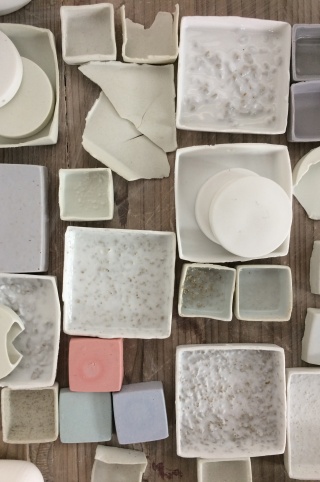and sustainability

Credits: Architecture Editor Wallpaper Photography: Studio Lotte Douwes, Studio Rolf.fr, Studio Nienke Hoogvliet, Studio Dirk Vander Kooij, Mathijs Labadie, Roel van Tour



Shadows of Light
Making a strong statement about supporting sustainable production methods, Rotterdam-based Lotte Douwes has been working on ‘Shadows of Light’, her research on kaolin, a fine white clay powder found in the mountains near Jingdezhen in China. This material is in high demand internationally due to its use in producing a translucent type of porcelain, but quality has been suffering as a result of heavy mining. The designer aims to flag up the industry’s impact on this unique natural resource by revealing that during the production process about 50% of the kaolin powder becomes waste material. Douwes advocates that these scraps can be collected and reused in a cyclical production method. To highlight how easy this is, the designer recently launched her ‘Circular’ collection, a series made using recovered material from traditional porcelain production that are then ground into a fine powder and mixed with white clay to produce the collection’s cups and saucers. Through this ongoing project, Douwes embraces eco-friendly, cyclical production methods while promoting a new, environmentally-conscious way of achieving fine, translucent porcelain.
House of Rolf
Utrecht-based architect and designer Rolf Bruggink partnered with fellow architect and designer Niek Wagemans to build a house built entirely from materials recycled from a demolished building next door. House of Rolf is Bruggink’s own home and involved the transformation of a 19th-century coach house situated at the rear of an existing villa. Using materials recovered from the demolition of a 1950s outbuilding on the same site, the team made bespoke furniture and a large floor-to-ceiling structure that sits at the heart of the 150 m2 home. Now, the open-plan ground-level interior contains the house’s main living spaces, while the tall timber structure at its core houses areas demanding greater privacy, such as a workspace and bedroom. Not only does House of Rolf provide a fine example of how to make the most of limited space through clever architectural solutions, it is also a fascinating showcase of how older structures can be reused and given a new lease of life through creative redesign.




Fibre Market
Drawing on Christien Meindertsma’s extensive research into textile companies and specifically wool production, ‘Fibre Market’ was conceived for the London Design Museum as part of its 2017 exhibition ‘Fear and Love’. For this conceptual installation, the Utrecht-born designer used 1000 discarded jumpers, sorting their fibres by colour and arranging each of them on piles. The piece reflects on the fact that up to 95% of unwanted textiles that end up in landfill could actually have been reused, highlighting the need for their recycling. At the same time, while working on the piece, Meindertsma realised that many of the jumpers labelled as 100% wool actually contained as little as 20-30% woollen fibres in their composition. This prompted a further investigation into how much – or indeed how little – we know about the products we consume. Meindertsma’s beautiful and neatly-arranged matrix of colourful fabrics may have been part of a temporary display, but it made a lasting impression, commenting on some of the textile industry’s most pressing and current environmental issues.



Mourn
The environmental impact of our remains when we shuffle off this mortal coil is probably not the first thing on one’s mind when considering our mortality, but this is exactly where Nienke Hoogvliet found inspiration; one of the up-and-coming Delft-based designer’s latest offerings is a cremation urn made entirely out of waste water. Fittingly entitled ‘Mourn’, the minimalist piece is designed to keep ashes safe in an eco-friendly way. The scattering of ashes often has a negative impact on nature because of the toxins and nutrients stored in the human body, says Hoogvliet. This piece, made using a bioplastic called PHA (Polyhydroxyalkanoate) that can be reclaimed through the Dutch water authorities, ensures this doesn’t happen. The material dissolves completely and naturally, so by putting ashes into this vessel and planting it in the earth, the toxins and nutrients included can be released to the ground gradually, allowing for better and safer absorption. Designed to work with different types of soil, the urn comes in three shapes, offering an environmentally-responsible and elegant way to lay a loved one to rest.

Endless Chair
Amsterdam-born Dirk Vander Kooij has been fascinated by 3D printing since his student days at the Design Academy Eindhoven. After his graduation in 2010, his design for the ‘Endless Chair’ won the prestigious Dutch Design Award in 2011 by proving that 3D printers can also be used to create larger items from recycled plastics. Vander Kooij achieved this by manipulating the printers to produce a continuous stream of plastic string out of recycled plastic parts and moulding it into a chair. He has since been working with recycled plastic; by developing an innovative robotic arm and a giant press, the designer can now transform waste into brand-new furniture and products; but that doesn’t mean that Vander Kooij is happy to just rest on his laurels. The designer has been constantly exploring new technologies. The possibilities are countless using Vander Kooij’s production methods, and now the designer can also create pieces using hollow tubes in a bid to further reduce the need for material resources.






